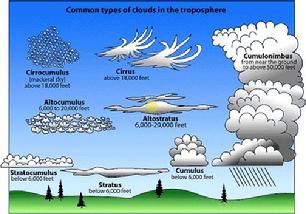|
Vincent Pica
Chief of Staff, First District, Southern Region (D1SR)
United States Coast Guard Auxiliary
|
|
Better Than Uncle Weatherby? Just Look Up!
Anybody who was borne prior to, say, 1970, can remember the newscaster/weatherman Tex Antoine, aka, Uncle Weatherby. While weather forecasting is far more reliable than ever before, it pales in our esteem for the mariner that can open the back door, look up, gaze knowingly for a second or two, and pronounce, “nah, we’ll be coming home in a whopper. Tomorrow will be better.” And, sure enough, a half day later, it is pouring…
This is all about that mariner…
Clouds are Batteries
Since this column started, we’ve written about the weather and seamanship three times (see “Skippering in Heavy Weather”, SSP, 10/11/06; “Lightning – Shocking!”, SSP, 3/07/07; “Weathering the Squall”, SSP, 11/28/07 – for copies email me below.) And, as those columns implied, clouds are batteries that store water and tremendous power. But the history of weather forecasting goes back to the dawn of time and is loaded with old wisdoms (“mare’s tails and mackerel scales make tall-ship captains take in their sails”) and many jokes, (“where else can you be so wrong so often and keep your job!?”) So, where does the weather, and these “sayings”, come from?
Part of the problem of weather forecasting was solved over a hundred years ago by British meteorologist, Luke Howard, when he devised a system of nomenclature that the rest of the world’s scientists were constantly arguing about. Every country wanted to use its own language and definitions for naming clouds and their effects. Howard came forward using – you guessed it – Latin and the fight was over. Meteorologists the world over accepted his type/sub-type system:
Cirrus (“hair”) – wispy, high-level clouds that foretell a major weather system on its way (the mare’s tails)
Stratus (“layer”) – these cloud formations have no specific feature except that they only form at specific altitudes (see the diagram)
Cumulus (“pile”) – the puffy clouds than coalesce into the thunderheads we all recognize that then presages the near immediate arrival of a major storm. BTW, the warmer the weather, the bigger they get (pile up into the sky.)
Nimbus (“precipitating”) – we’re all familiar with these. By this time, it’s raining. And, the darker they are, the more water they are carrying.
Alto (“high”) – like in music, while it means high, it means the second-highest (soprano or treble is higher in music) and cirrus’s and, often, the cumulo’s (thunderheads) are even higher.
|
Look Up!
Watching the weather over hours or even days, often subconsciously by that back-door mariner, adds to your skills in predicting the weather. And it is all about the sun, the sea and the land interacting.
The sun heats the land faster than the sea. The warm air rises, taking some moisture from the sea, lakes, creeks and rivers with it, and forms cumulus (puffy) clouds.
|
 |
| click to expand - Courtesy of University Corporation for Atmospheric Research, 2008 |
|
|
This vacuum effect then brings in cooler air from the sea to fill the gap created by the rising air over the land and we have what we call a sea-breeze (“winds are known from whence they blow, currents are known for whence they flow.”) The opposite effects happen at night, as you might guess. The land cools faster and the process reverses. All this is generally called “convection.” And where convection is occurring, clouds are forming – and they are batteries storing up water and power.
Blankets presage Rain
Another sign that weather is approaching is when the sky cover builds and the sea breeze stops… The cloud cover has now gotten so thick that the sun can’t heat the air underneath the clouds. That’s when someone mutters, “Please, let it rain and clear out this humidity…” The cloud is acting like a blanket – and you know how much you like blankets in the summertime!
Ancient mariners looked for clouds for two reasons. They didn’t know that convection was causing the wind but clouds meant wind. They also meant land. Convection first lines the shore line with clouds. “Land Ho’!” And it builds from there.
Some more proverbs? See if you can divine why they are true, based on what you now know:
“The moon with a circle brings water in her beak…”
“Rain before seven? Over by eleven.”
“Red sky at morning? Sailor take warning!”
|
BTW, if you are interested in being part of USCG Forces, email me at JoinUSCGAux@aol.com or go direct to the D1SR Human Resources department, who are in charge of new members matters, at DSO-HR and we will help you “get in this thing…”
|
| <-- click there to tweet, post or otherwise distribute to the 'net
|
|